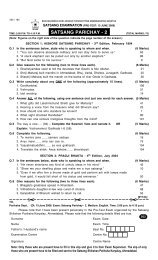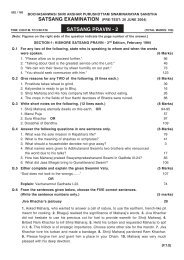August 2009 Annual Subscription Rs. 60 - Swaminarayan Sanstha
August 2009 Annual Subscription Rs. 60 - Swaminarayan Sanstha
August 2009 Annual Subscription Rs. 60 - Swaminarayan Sanstha
You also want an ePaper? Increase the reach of your titles
YUMPU automatically turns print PDFs into web optimized ePapers that Google loves.
PHILOSOPHY – SWAMINARAYAN VEDANT: GUJARATI TEXT: SADHU BHADRESHDAS: TRANSLATION: SADHU PARAMVIVEKDAS<br />
The Mundaka Upanishad Proclaiming the<br />
Akshar-Purushottam<br />
Principle<br />
Part-2<br />
entity. This is the very reason the eighth chapter<br />
of the Gitã is called the ‘Aksharbrahman Yoga’ –<br />
putting both words together. That is why in the<br />
<strong>Swaminarayan</strong> Sampradaya as well, the joint name<br />
‘Aksharbrahman’ is used for this divine entity.<br />
ANOTHER NAME OF AKSHAR: ‘BRAHMAN’<br />
First Angirã Rishi used the word ‘Akshar’ for the<br />
divine entity which is the cause of the whole world.<br />
Then to make it known that this entity called<br />
Akshar is also known as ‘Brahman’, Angirã uses the<br />
word ‘Brahman’ instead of Akshar when he explains<br />
how Akshar causes creation. For example, ‘ÌÂâæ<br />
¿èØÌð ‘Õýræ’ ’ – ‘Tapasã cheeyate ‘Brahma’ ’ (Mundaka<br />
Upanishad: 1/1/8), ‘ÌS×æÎðÌÎ÷ ‘Õýræ’ï Ùæ× M¤Â×óæ¢ ¿ ÁæØÌð’<br />
– ‘Tasmãdetad ‘Brahma’ nãma roopamannam cha<br />
jãyate’ (Mundaka Upanishad: 1/1/9).<br />
The Bhagavad Gitã also reinforces this fact.<br />
In the first shloka of the eighth adhyãy (chapter),<br />
Arjuna enquires about the Brahman entity, ‘ç·¢¤ ÌÎ÷<br />
Õýræï’ – ‘Kim tad Brahma’ – ‘What is that Brahman?’<br />
(Gitã: 8/1). Krishna Bhagwan answers using<br />
the word Akshar for Brahman ‘¥ÿæÚ¢U Õýræï ÂÚU××÷’ –<br />
‘Aksharam Brahma Paramam’ – Akshar, which is<br />
above jivas, ishwars, mãyã and muktas, is Brahman<br />
(Gitã: 8/3). The only difference is that in the<br />
Mundaka Upanishad Brahman has been used in<br />
the place of Akshar, and in the Bhagavad Gitã,<br />
Akshar in the place of Brahman. Hence, Akshar<br />
and Brahman are two synonyms of the same<br />
AKSHARBRAHMAN: ALL-PERVADING<br />
In addition to being the cause of creation,<br />
Aksharbrahman is also shown as pervading all<br />
creation.<br />
Wherever there is an effect, there is a cause. By<br />
Paramãtmã’s wish, Aksharbrahman is the cause of<br />
all. The whole of creation is its work. Therefore,<br />
wherever the world is, its cause, Aksharbrahman,<br />
is there as well. This is the all-pervasiveness<br />
of Aksharbrahman. Maharshi Angirã says that<br />
this Aksharbrahman is ‘âßü»Ì×÷’ – ‘Sarvagatam’<br />
– ‘all-pervasive’ (Mundaka Upanishad: 1/1/6)<br />
by its omniscience. Moreover, O Shaunak!<br />
There are many other traits that come with<br />
being all-pervasive. These are also present in<br />
Aksharbrahman, ‘ÕëãU“æ ÌÎ÷ çÎÃØ×ç¿‹ˆØM¤Â¢ âêÿ×æ“æ ÌÌ÷<br />
âêÿ×ÌÚ¢U çßÖæçÌÐ ÎêÚUæÌ÷ âéÎêÚðU ÌçÎãUæç‹Ì·ð¤ ¿ ÂàØçˆSßãñUß çÙçãUÌ¢<br />
»éãUæØæ×÷H’ – ‘Bruhachcha tad divyamchintyaroopam<br />
sookshmãchcha tat sookshmataram vibhãti, doorãt<br />
sudoore tadihãntike cha pashyatsvihaiva nihitam<br />
guhãyãm’ (Mundaka Upanishad: 3/1/7). Meaning,<br />
the divine and unimaginable Aksharbrahman is<br />
extremely large and bigger than everything. (That<br />
is why it is called ‘Brahman’.) It is subtler than the<br />
subtle. It is farther than the farthest and yet near<br />
(because it is everywhere). And whosoever realizes<br />
it, experiences it residing within their hearts.<br />
<strong>August</strong> <strong>2009</strong> <strong>Swaminarayan</strong> Bliss 9
















